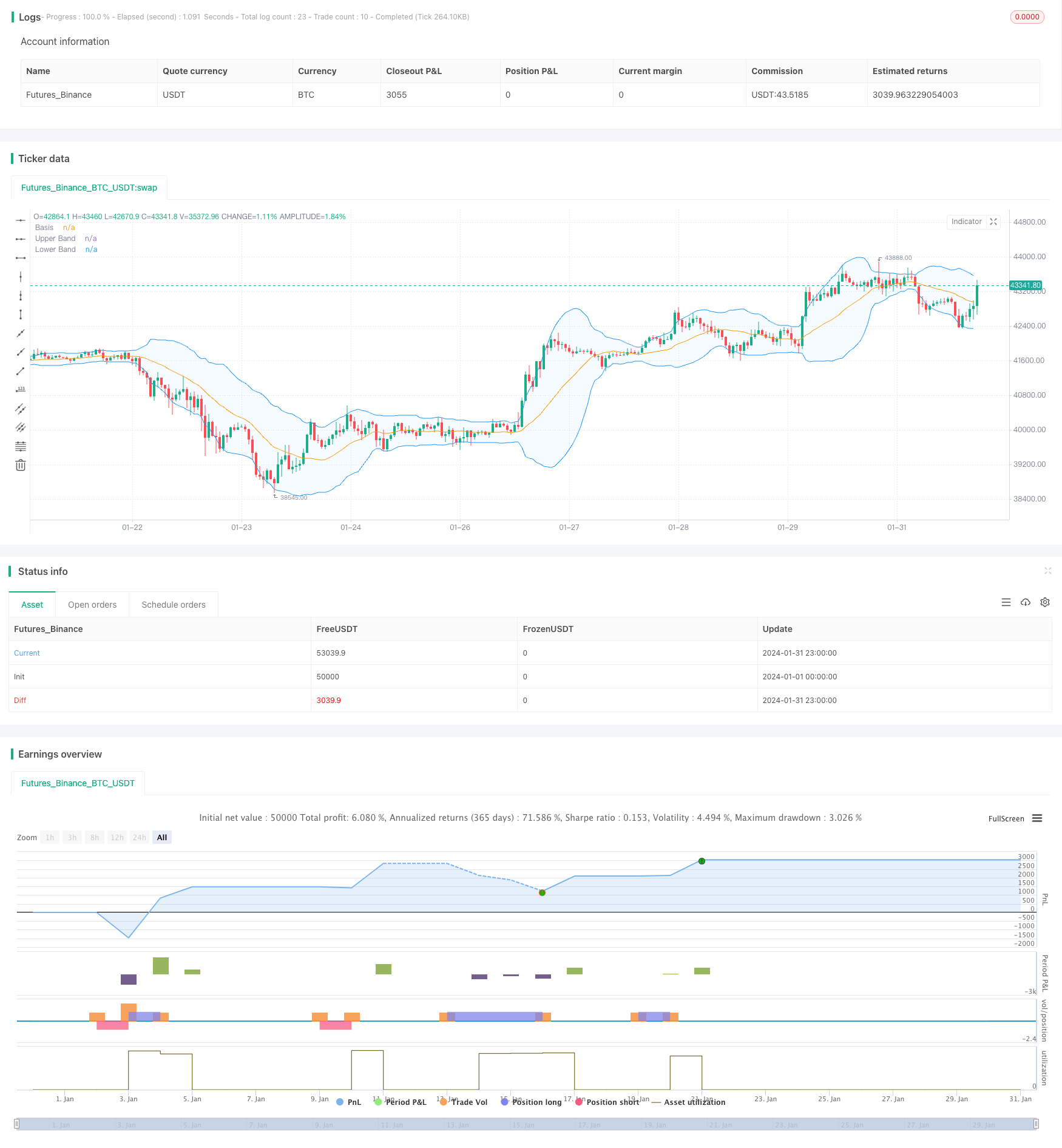
概述
本策略融合了布林带指标、RSI指标以及多时间框架分析,旨在捕捉中长线趋势的方向。通过布林带上轨和下轨突破结合RSI过买过卖信号判断趋势反转点,实现低风险进场。同时应用更高时间框架过滤震荡行情,避免被套。
策略原理
应用布林带指标判断价格突破。布林带中轨为N日收盘价的移动平均线,上轨和下轨分别是中轨上下各自一个标准差。当收盘价突破上轨时为强势信号,突破下轨时为弱势信号。
结合RSI指标判断超买超卖现象。RSI大于70为超买区,小于30为超卖区。当RSI从下向上突破70时,认为处于超买状态,布林带上轨突破作为趋势反转的确认。 当RSI从上向下突破30时,认为处于超卖状态,布林带下轨突破作为趋势反转的确认。
应用更高时间框架过滤假突破。当日线出现突破信号时,需要4小时或更高时间框架作为确认,避免被套。
策略优势
多指标融合,提高策略的稳定性和盈利率。
RSI指标判断反转点,可以减少假突破带来的损失。
多时间框架分析,有效过滤震荡走势,避免被套。
突破信号判断优化(3根K线都要突破布林带上下轨),确保趋势发展成熟后再入场。
Vortex指标判断趋势方向,能够捕捉开始形成的新趋势。
策略风险
布林带参数设置不当可能导致超买超卖信号错误。
RSI参数设置需要根据不同品种确定合理数值。
突破信号可能出现假突破,应适当放大止损点差。
保证充足的止损幅度,如ATR指标的3倍。
策略优化方向
应用机器学习算法实时优化布林带和RSI的参数。
利用波动率指标优化止损点差。
增加交易量控制模块,根据市场变化调整仓位。
结合资金管理原则,限制单笔交易亏损比例。
评估不同交易时段突破信号的稳定性。
总结
本策略综合考虑了趋势判断、超买超卖现象、多时间框架分析等多种技术指标,在控制风险的前提下,选择合适的进场时机,捕捉中长线质量趋势,能够获得较好的盈亏比。同时也有进一步优化的空间,通过参数调优、止损机制完善等手段,可望获得更出色的投资业绩。
/*backtest
start: 2024-01-01 00:00:00
end: 2024-01-31 23:59:59
period: 1h
basePeriod: 15m
exchanges: [{"eid":"Futures_Binance","currency":"BTC_USDT"}]
*/
// This Pine Script™ code is subject to the terms of the Mozilla Public License 2.0 at https://mozilla.org/MPL/2.0/
// © Noway0utstorm
//@version=5
strategy(title='Vortex0.71.3 + bb 3bar breakout + rsi - close hit upper or lower', shorttitle='truongphuthinh', format=format.price, precision=4,overlay = true)
length = input(20, title="Length")
mult = input(2.0, title="Multiplier")
source = close
basis = ta.sma(source, length)
dev = mult * ta.stdev(source, length)
upperBand = basis + dev
lowerBand = basis - dev
isClosedBar = ta.change(time("15"))
var bool closeAboveUpperBand = false
var bool closeBelowLowerBand = false
// Vortex Indicator Settings
period_ = input.int(14, title='Period', minval=2)
VMP = math.sum(math.abs(high - low[1]), period_)
VMM = math.sum(math.abs(low - high[1]), period_)
STR = math.sum(ta.atr(1), period_)
VIP = VMP / STR
VIM = VMM / STR
//
lengthrsi = input(14, title="RSI Length")
overboughtLevel = input(70, title="Overbought Level")
oversoldLevel = input(30, title="Oversold Level")
sourcersi = close
rsiValue = ta.rsi(sourcersi, lengthrsi)
shouldShort = rsiValue > overboughtLevel
shouldLong = rsiValue < oversoldLevel
if bool(isClosedBar[1]) and bool(isClosedBar[2]) and bool(isClosedBar[3])
if close[1] > upperBand[1] and close[2] > upperBand[2] and close[3] > upperBand[3] and VIP > 1.25 and VIM < 0.7 and rsiValue > overboughtLevel
strategy.entry("Short", strategy.short)
closeAboveUpperBand := false // Reset the condition when entering a new Short position
if close[1] < lowerBand[1] and close[2] < lowerBand[2] and close[3] < lowerBand[3] and VIP < 0.7 and VIM > 1.25 and rsiValue < oversoldLevel
strategy.entry("Long", strategy.long)
closeBelowLowerBand := false // Reset the condition when entering a new Long position
if strategy.position_size > 0 // Check if there is an open Long position
closeAboveUpperBand := close > upperBand // Update the condition based on close price
if closeAboveUpperBand
strategy.close("Long",disable_alert=true) // Close the Long position if close price is above upper band
if strategy.position_size < 0 // Check if there is an open Short position
closeBelowLowerBand := close < lowerBand // Update the condition based on close price
if closeBelowLowerBand
strategy.close("Short",disable_alert=true) // Close the Short position if close price is below lower band
// Plots
plot(basis, color=color.orange, title="Basis")
p1 = plot(upperBand, color=color.blue, title="Upper Band")
p2 = plot(lowerBand, color=color.blue, title="Lower Band")
fill(p1, p2, title = "Background", color=color.rgb(33, 150, 243, 95))